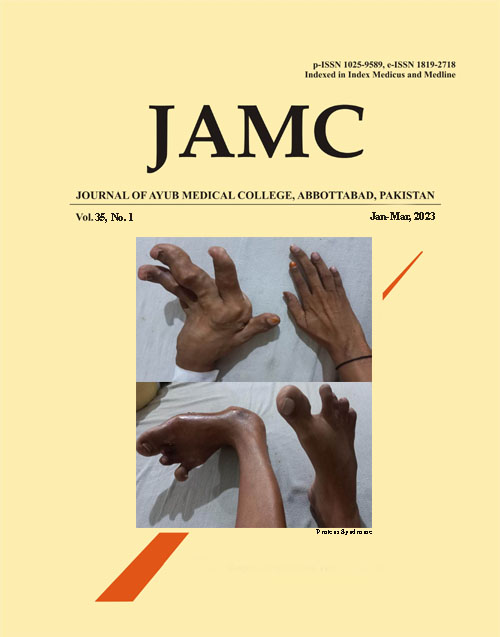OUTCOME OF THE DISTAL RADIUS FRACTURES MANAGED WITH ACROSS WRIST EXTERNAL FIXATOR VS BUTTRESS PLATE
DOI:
https://doi.org/10.55519/JAMC-01-10605Keywords:
Across wrist external fixator, Buttress plate, Distal radius fracture.Abstract
Background: Distal radius fracture is one of the most common injuries presented to emergency department and can be presented in any age group. In young patients the most common cause is Road Traffic Accident (RTA), while old patient history of fall is the most common cause. Different surgical options are available to treat this injury. This study aims to compare the outcome of volar buttress plate vs across wrist external fixator for Arbeitsgemeinschaft für Osteosynthesefragen (AO) type C2/C3 fracture of the distal radius. Methods: A retrospective comparative study between July 2020 to June 2021 at Ghurki Trust Teaching Hospital was done and a total of 50 patients who underwent surgical intervention for AO C2/C3 fracture of the distal Radius, were included. The follow-up period was 12 weeks. QuickDASH score was used to find out patient's functional outcomes. Functional outcome was analyzed between the two groups using Mann-Whitney U test, using SPSS version 21. Result: There was no significant statistical difference between the functional outcome of patients with distal radius fracture treated with across wrist external fixator vs volar buttress plate, in term of QuickDASH score. Furthermore, age and gender also were having no effect on functional outcome in our population. Conclusion: Across wrist external fixator is a reasonable option for AO C2/C3 type fractures of the distal radius with comparable results with volar buttress plate. It is the procedure of choice in high volume tertiary care hospitals like Gurki Trust Teaching hospital as it saves time, have similar functional outcome score, no need to re-open for removal of implant, less chances of tendon rupture as compared to volar buttress plate for distal radius fracture.
References
Lizaur-Utrilla A, Martinez-Mendez D, Vizcaya-Moreno MF, Lopez-Prats FA. Volar plate for intra-articular distal radius fracture. A prospective comparative study between elderly and young patients. Orthop Traumatol Surg Res 2020;106(2):319-23.
Mauck BM, Swigler CW. Evidence-based review of distal radius fractures. Orthop Clin 2018;49(2):211-22.
Ranjeet N, Onta PR, Sapkota K, Thapa P, Wahegoankar K, Thapa UJ. Use of Cobra External Fixator for treatment of Distal Radius Fractures. Asian J Med Sci 2018;9(6):84-9.
Zengin EC, Ozcan C, Aslan C, Bulut T, Sener M. Cast immobilization versus volar locking plate fixation of AO type C distal radial fractures in patients aged 60 years and older. Acta Orthop Traumatol Turc 2019;53(1):15-8.
Auer JA. Fractures of the radius. Equine Fract Repair 2019:527-44.
Brennan SA, Kiernan C, Beecher S, O'Reilly RT, Devitt BM, Kearns SR, et al. Volar plate versus k-wire fixation of distal radius fractures. Injury 2016;47(2):372-6.
Brismée JM, Pape JL, Woodhouse LJ, Reid D, Bellot N, Matthijs OC, et al. Reflections and future directions on extending physical therapist scope of practice to improve quality of care and preserve health care resources. Phys Ther 2018;98(10):827-9.
Larouche J, Pike J, Slobogean GP, Guy P, Broekhuyse H, O'Brien P, et al. Determinants of functional outcome in distal radius fractures in high-functioning patients older than 55 years. J Orthop Trauma 2016;30(8):445-9.
Rosenauer R, Pezzei C, Quadlbauer S, Keuchel T, Jurkowitsch J, Hausner T, et al. Complications after operatively treated distal radius fractures. Arch Orthop Trauma Surg 2020;140(5):665-73.
Johnson N, Dias J, Wildin C, Cutler L, Bhowal B, Ullah A. Comparison of distal radius fracture intra-articular step reduction with volar locking plates and K wires: a retrospective review of quality and maintenance of fracture reduction. J Hand Surg Eur Vol 2017;42(2):144-50.
Toon DH, Premchand RAX, Sim J, Vaikunthan R. Outcomes and financial implications of intra-articular distal radius fractures: a comparative study of open reduction internal fixation (ORIF) with volar locking plates versus nonoperative management. J Orthop Traumatol 2017;18(3):229-34.
Prakash JS, David V, Bhatty S, Deane A, Mahajan A. Across wrist external fixation for distal radius fractures in adults. WebmedCentral Orthop 2015;6(8):WMC004959.
Dwivedi S, Pal CP, Safdar K. Comparison of outcome of fracture distal end radius treated by external fixator versus volar plating. Int J Orthop 2020;6(2):715-8.
Wright TW, Horodyski M, Smith DW. Functional outcome of unstable distal radius fractures: ORIF with a volar fixed-angle tine plate versus external fixation. J Hand Surg 2005;30(2):289-99.
Richard MJ, Wartinbee DA, Riboh J, Miller M, Leversedge FJ, Ruch DS. Analysis of the complications of palmar plating versus external fixation for fractures of the distal radius. J Hand Surg 2011;36(10):1614-20.
Downloads
Published
How to Cite
Issue
Section
License
Journal of Ayub Medical College, Abbottabad is an OPEN ACCESS JOURNAL which means that all content is FREELY available without charge to all users whether registered with the journal or not. The work published by J Ayub Med Coll Abbottabad is licensed and distributed under the creative commons License CC BY ND Attribution-NoDerivs. Material printed in this journal is OPEN to access, and are FREE for use in academic and research work with proper citation. J Ayub Med Coll Abbottabad accepts only original material for publication with the understanding that except for abstracts, no part of the data has been published or will be submitted for publication elsewhere before appearing in J Ayub Med Coll Abbottabad. The Editorial Board of J Ayub Med Coll Abbottabad makes every effort to ensure the accuracy and authenticity of material printed in J Ayub Med Coll Abbottabad. However, conclusions and statements expressed are views of the authors and do not reflect the opinion/policy of J Ayub Med Coll Abbottabad or the Editorial Board.
USERS are allowed to read, download, copy, distribute, print, search, or link to the full texts of the articles, or use them for any other lawful purpose, without asking prior permission from the publisher or the author. This is in accordance with the BOAI definition of open access.
AUTHORS retain the rights of free downloading/unlimited e-print of full text and sharing/disseminating the article without any restriction, by any means including twitter, scholarly collaboration networks such as ResearchGate, Academia.eu, and social media sites such as Twitter, LinkedIn, Google Scholar and any other professional or academic networking site.









